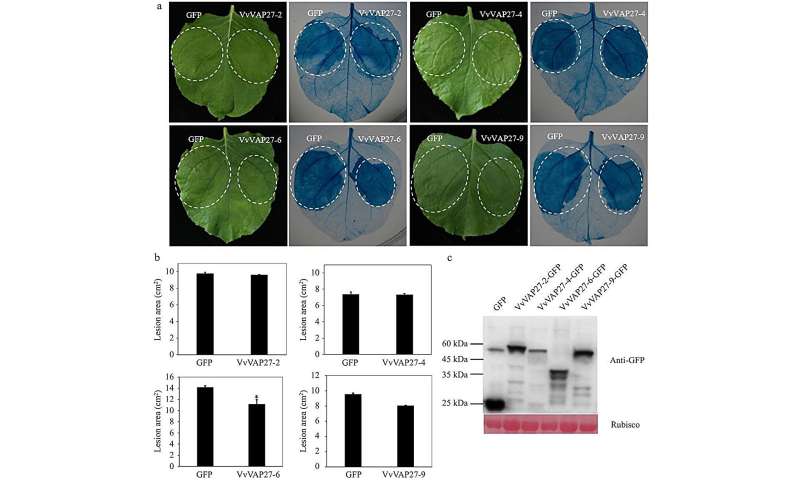New study identifies key VAP27 genes in grapevine, enhancing disease resistance potential

A research team identified 12 vesicle-associated protein-membrane protein (VAP27) genes in the grapevine genome by bioinformatics, revealing their diverse subcellular localizations and roles in disease resistance. This study highlights the induction of VAP27 genes in response to downy mildew and their ability to inhibit Phytophthora capsici infection.
These findings provide a foundation for future research on VAP27's role in plant growth and immunity, potentially leading to improved disease-resistant grapevine cultivars.
The vesicle-associated membrane protein (VAMP)-associated protein (VAPs) family is highly conserved in both plants and animals, playing crucial roles in various biological processes. To date, much research on VAPs has been reported in the plant kingdom, leading to the discovery of an increasing number of proteins associated with VAPs.
Grapevine (Vitis vinifera L.), a valuable crop for fresh consumption and wine production, faces significant challenges from environmental and biotic stresses. However, research on VAP27 proteins in grapevine remains limited.
A study published in Fruit Research on 17 May 2024, aims to identify and analyze the VAP27 protein family in grapevine, laying the groundwork for understanding their function in grapevine growth and stress response.
In this study, researchers identified 12 VAP27 genes in the grape genome, named VvVAP27-1 to VvVAP27-12 according to their chromosomal positions.
The genomic distribution revealed an uneven mapping of VAP27s on eight out of the 19 grape chromosomes. Phylogenetic analysis of 53 VAP members from grape, Arabidopsis, rice, and tomato revealed three clades, and the clustering patterns suggest a closer evolutionary proximity of the VAP family in grapes to tomatoes.
Structural analysis showed diverse exon/intron patterns among VvVAP27 genes, with significant motif variations indicating functional differentiation.
Expression profiling across grapevine tissues revealed that most VvVAP27 genes (VvVAP27-1 to VvVAP27-10) were actively expressed in various organs, while VvVAP27-11 and VvVAP27-12 exhibited tissue-specific expression. Furthermore, the expression patterns of VAP27 genes were examined post-plasmopara viticola inoculation.
VvVAP27-3, VvVAP27-6, VvVAP27-11, and VvVAP27-12 genes were highly expressed throughout the downy mildew infection period in "Pinot Noir," highlighting their role in pathogen response. Subcellular localization studies showed that most VvVAP27 proteins localized to the ER, with some also present in the nucleus.
Functional assays in tobacco leaves indicated that VvVAP27-6 and VvVAP27-9 effectively inhibited pathogen lesions, suggesting their potential in enhancing disease resistance.
According to the study's lead researcher, Guotian Liu, "These results provide an important basis for further studies delving into the functions of the VAP27 gene family in plant growth and disease resistance."
In summary, this study identified 12 VAP27 genes in the grapevine genome, revealing their chromosomal distribution, structural diversity, and phylogenetic relationships with Arabidopsis, rice, and tomato. Expression profiling showed tissue-specific roles and significant responses to downy mildew infection.
Subcellular localization confirmed ER and nucleus presence, while functional assays demonstrated that VvVAP27-6 and VvVAP27-9 enhance disease resistance. Future research should focus on the molecular mechanisms and broader roles of VvVAP27 genes to develop disease-resistant grapevine cultivars.
More information:
Ruonan Li et al, Identification and characterization of grape VAP27 gene family and their roles in disease resistance, Fruit Research (2024). DOI: 10.48130/frures-0024-0019
Provided by TranSpread